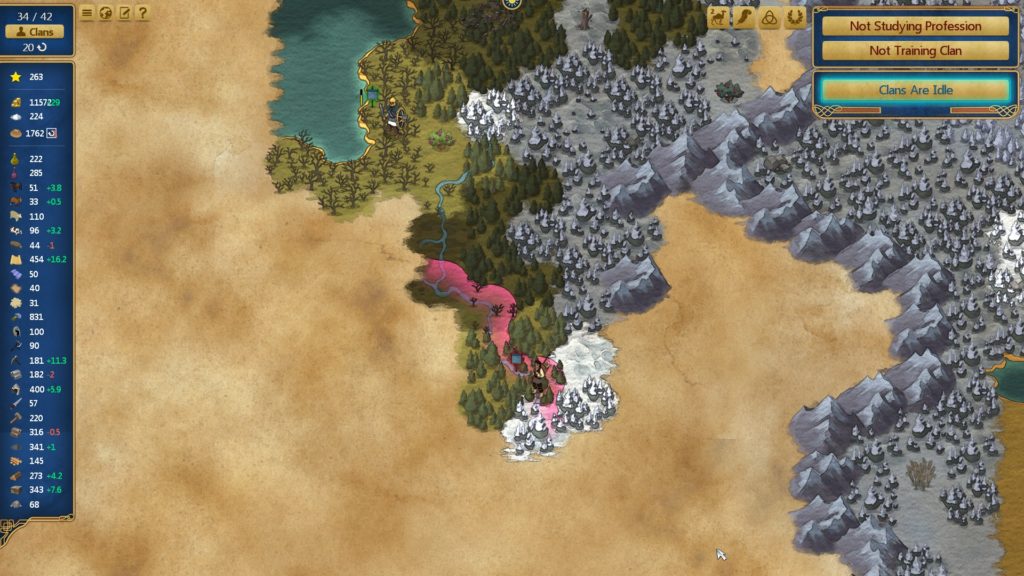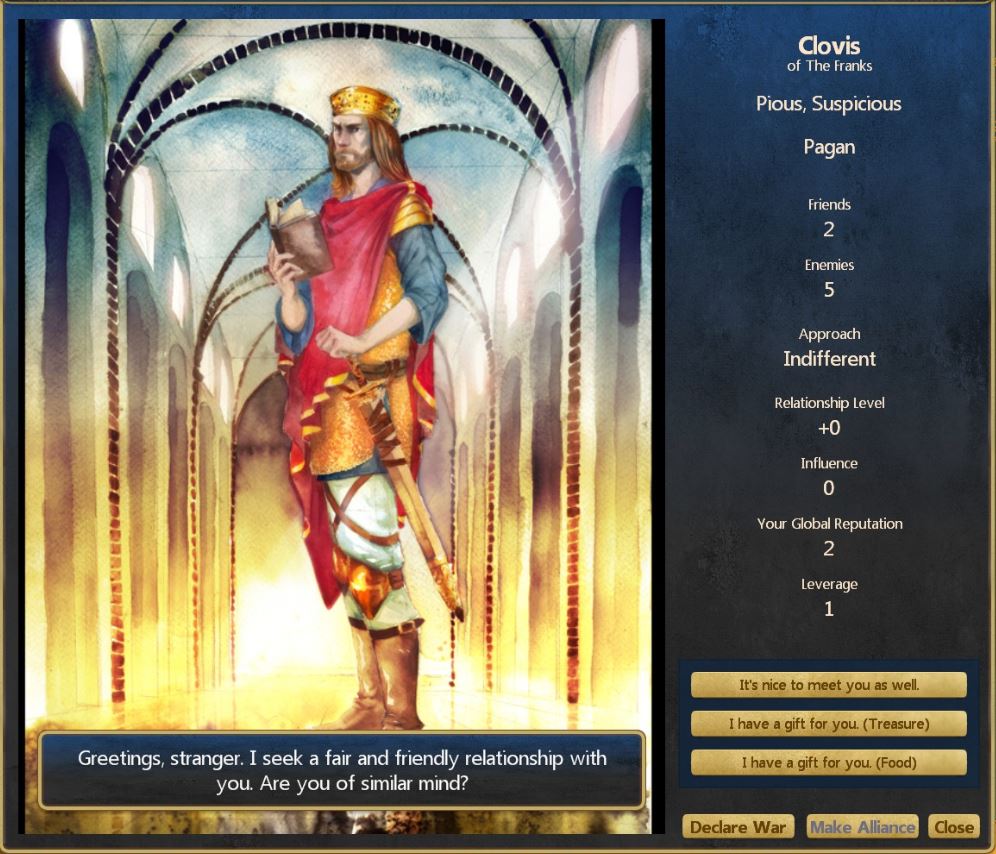This post is the second half of a two-part article on Jon Shafer’s At the Gates, at launch. You can read part 1 by clicking here.
So I’ve given you a rundown of At the Gates’ (AtG) critical reception at launch, discussing the good, the bad, and the ugly of Shafer’s first solo entry into strategy games. In the spirit of Emily Bembeneck’s 2013 interview with Shafer, I’d also like to contribute to the conversation by peering under the conceptual hood of AtG. In her interview, Bembeneck didn’t just get Shafer to discuss the core features of his game, but also asked him to describe aspects of the historical period his game is trying to model in its mechanics and game systems, and represent with its aesthetic and player objectives.
I’d like to follow Bembeneck down this path, and add Alister MacQuarrie’s critique of 4X game design on Rock Paper Shotgun to the pot. In his article “All rise and no fall: how Civilization reinforces a dangerous myth”, MacQuarrie addresses a key design issue of 4X games by pointing out that the economic engines modeled in such games inevitably lead to perpetual growth, and expansion. In a franchise like Sid Meier’s Civilization, this results in an (oft-critiqued) vision of history as a process of linear cultural and technological development. As MacQuarrie points out, such a “growth engine” design may be fun for Empire-building, but it also leaves important historical developments such as cultural and economic decline – not to mention ecological disaster – beyond the reach of historical simulations.
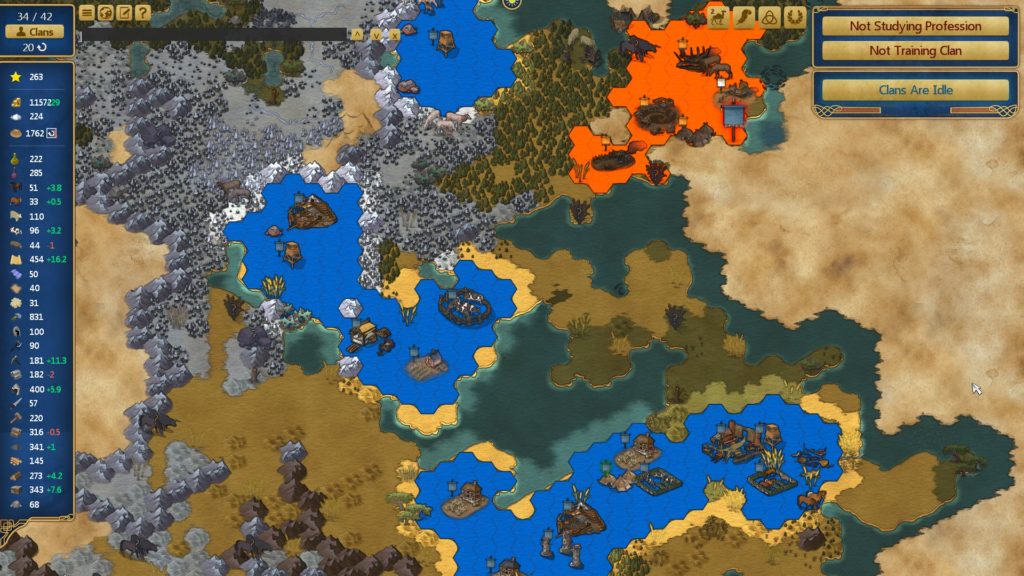
Following MacQuarrie, my question to Shafer is: can we model cultural and economic decline in the 4X genre? Clearly, Shafer was cognizant of such issues while he was putting together his core vision for the game. Critics seemed to have picked up on the fact that Shafer shifted the scope of 4X mechanics in AtG version 1.0 away from Empire-building, to focus the player on tribal expansion. In other words, the inherent expansionism of 4X is still a core design feature of AtG, but limits impinge on this growth from both within (clan management) and without (tribal adaptation to the surrounding natural environment). The main gameplay loop remains expansionist, even if the game also tries to model the decline of Roman might. As far as we can tell, AtG is still 4X at its core – though, as one critic pointed out, we explore, expand, exploit way more than we exterminate.
Here’s my overview of the AtG, after playing the game for roughly 20 hours.
Thematically-speaking – and as far as I can tell – instead of aiming for historical accuracy, AtG is interested in getting players to peek at the “inner workings” of the conquering tribal cultures operating at the periphery of the late Roman Empire. AtG depicts the “cultural and economic engine” of tribal growth and development, and the conditions that impeded on this development.
By eschewing realism, Shafer has taken a clear stance toward telling stories from the past (in our case, the “barbarian” invasions at the times of Rome’s split) through game mechanics. With its visual watercolor style and unique take on 4X mechanics, AtG offers a “procedural expression” of a specific historical reality in the form of a strategy game. Put simply, AtG works as a “storytelling engine”: each playthrough offers a unique configuration of environmental constraints that allow players to tell stories about the rise of barbarian kingdoms and their conquest of Rome.
How does AtG do this?
- AtG’s core gameplay combines both 4X and economic sim mechanics – the “survival” twist on the standard 4X formula.
- Clan management in time and space (unit training and deployment) is AtG’s core gameplay loop, or Shafer’s own refinement of your typical “explore, expand, exploit and exterminate” 4X gameplay loop.
- Tribe and clan skills and traits, as well as the game map play a defining role in the player’s strategy. The player has to make constant allocation decisions in response to environmental pressure and the cyclical constraints of seasons and visiting caravans.
- Game loop “internal” constraints: Shafer has designed player choice around the classic opportunity cost decision-making model. For example: only one clan can be trained and only one profession can be researched at a a time. There are six disciplines to choose from, and switching disciplines incurs retraining penalties. Conflicts between clans force the player to penalize one, and reward the other. The effects of cost-benefit decisions can only be measured out over many turns, which adds a level of suspense – or frustration, depending on your mood.
- Replayability: unlockable tribe factions, a mix-and-match profession system, the movable settlement mechanic and rogue-like map generation give the game high replayability value. That said, the core gameplay loop’s key constraints keep the player on a tight leash; alongside the “one turn at a time” slow pace, this tends to make the game feel rather repetitive. Beyond this, as a “storytelling engine”, AtG’s replayability allows the player to “test out” different scenarios and evaluate the historical constraints that beset barbarian kingdoms pressing on the gates of Rome.
A few additional comments on AtG’s design concepts.
First, the AtG “clan” system. In AtG, the “clan” character-unit system mixes RPG elements with classic 4X unit deployment. Ingeniously, RPG-like character traits, skills and specializations are blended with AtG’s version of the 4X “tech tree”, the “professions” mechanic. Players start with the traits of individual “clans” (characters). But instead of focusing on character customization and progession, as one would in an RPG, AtG ditributes its skills across the entire tribe, and the player must then assign “class” skills to right clan, at the right time.
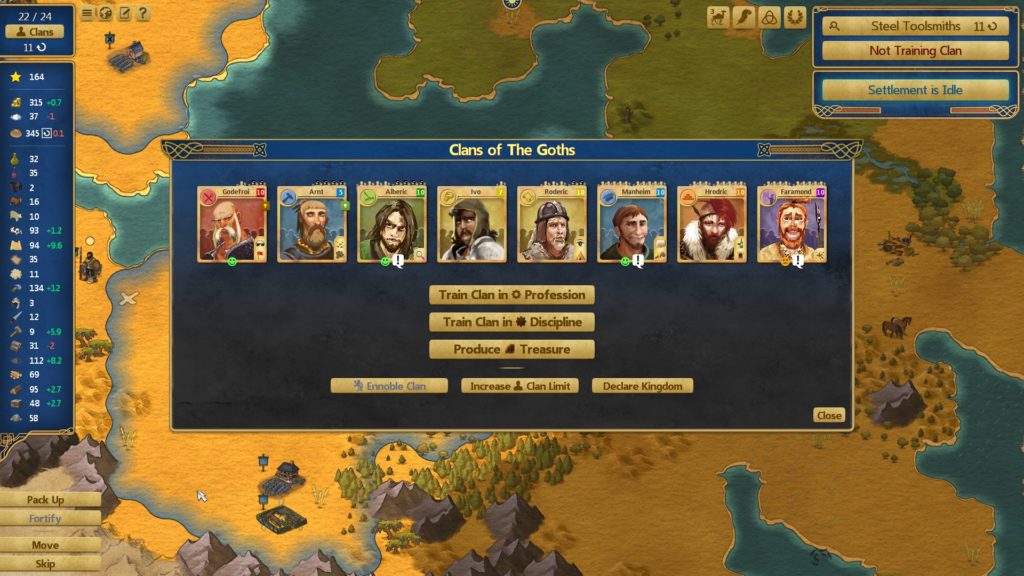
Although calling characters “clans” serves to immerse the player in the setting of the game, clans pretty much function as a 4X “collective” unit, with the added RPG touch. The RPG-like elements tend to “flatten” clans as collective characters to their individual pictorial representation. In other words, one feels like one is playing a 4X “RPG”, managing units with RPG-like traits.
Expansion in AtG: Sid Meier’s Civilization series famously commits players to urban development, and empire expansion. Expressed mechanically, this meant that scout units turned into city founders. Once a settlement is fixed, the player must develop her Civ in a geographically concentric fashion, from the urban core outward. AtG avoids this urban-centric conceit, by allowing players to stay nomadic. You make the best of an immediate environment; when this isn’t possible anymore, you move. Alongside the rogue-like map generation and the unlockable tribe factions, the movable settlement mechanic is perhaps the single feature that adds the most replayability to AtG. This mechanic also tempers the inherent expansionism of 4X games.
AtG economics and technology: Shafer has also given the typical 4X “tech progression” mechanic an original twist. Players can assign (and change at any time) disciplines and professions to their “clans”. Profession “training” is thus pooled at the tribal level, with players making allocation decisions based on clan traits, and current needs. This offers a vision of a “tribal division of labor” that is unit-based, but not permanently assigned to a unit-character, as is the case with RPG’s. This is an original take on small-scale society division of labour, like Banished with its “labor pool” that can be assigned to professions at will. Unlike Banished, AtG pushes the player to make strategic instead of logistical choices with the labour pool, because the opportunity cost of every clan profession allocation, or switch, is tied to mid-term planning, instead of the short-term time-frame of Banished production cycles. As already mentioned, enviromental factors also play an important part in squeezing players into profession choice dilemmas.
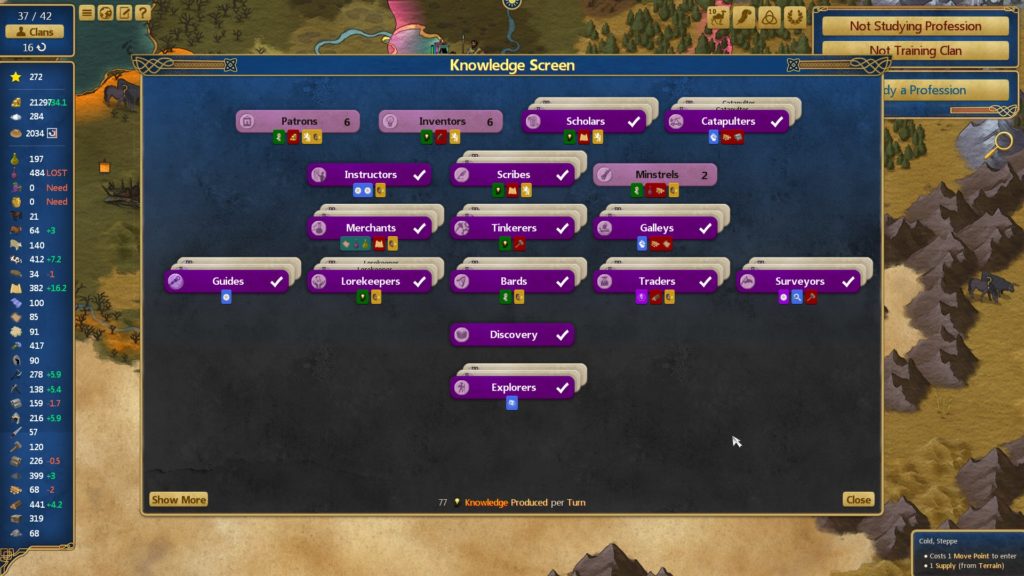
Like any self-respecting 4X, AtG’s tech tree mechanic is additive. This progressive view of technology is embedded in the assumptions of the 4X genre: you unlock technology “advances”, which allows you in turn to scale your operations and further specialize ecnomomic functions. But AtG does not by default espouse a technologically deterministic vision of history. The tech tree-like unlockable “professions” are presented as the labor/social specializations of tribal societies of the period. You don’t “progress” from one era to the next, thanks to economic and culture tech “advances”; you simply gain access to more specialized social functions, to help scale your mobile tribal society toward permanent settlement, so it can adapt to and take over the declining Roman imperial infrastructure.
And so if your classic 4X strategy game reinforces the myth of linear civilizational progress, Shafer’s original take on 4X expansion is an expression of the scaling of nomadic culture, being “forced” into the mold of sedentary, hierarchical society as it becomes a economic and military contender against a divided Roman imperium.
“Graecia capta ferum victorem cepit et artes intulit agresti Latio. – Greece, the captive, made her savage victor captive, and brought the arts into rustic Latium”, once famously quipped Horace. Just the same, the conquering barbarians, in Jon Shafer’s model history, may have taken up some Roman ways, on their way to the gates of Rome.
At the Gates, and Into the Future
To conclude, here are the salient points about AtG’s release:
- Shafer has survived the ordeal of development, and the small dev team is dedicated to improving the game over the coming months.
- The official criticism is rather polarized: from high praise of Shafer’s design vision, to panning of the execution of said vision.
- Shafer and his team are planning for substantive updates in the coming year, focused on quashing bugs, balancing the game, improving the AI and the user interface, and adding modding capabilities.
- Though it is categorized as a 4X game, I expect that the issue of which genre AtG “belongs to” won’t be easily settled in future discussions of this game. If the “strategy game” label seems obvious, some critics are calling AtG “an economic sim in a 4X skin”.
Here are a few Play the Past musings, for player-readers who want to give AtG more consideration:
- What kind of “historicity” is modeled in AtG? By definition, the 4X genre carries with it an expansionist vision of human cultural development. How is AtG’s treatment of this unique, or different?
- How do games treating the collapse of the Roman Empire treat this important event in world history? Again, How is AtG’s treatment of this unique, or different?
- Does AtG “subvert” some of the main tropes of the 4X genre? For example, 4X games are typically inifinite growth-and-expansion engines. AtG is supposed to portray tribal growth in relation to declining Roman power. But do the Romans as an AI “bot” in AtG share the same core mechanics that players do? Or is the Roman bot given another set of mechanics to model its decline ?
- What theory of human culture does AtG express? At both the aesthetic and procedural levels?
- How can history enthusiasts “use” AtG’s “model civ” to generate research questions about the historical events/period referenced by the game?
We will be back in a year or so, when Conifer Games has had the chance to provide important updates to AtG, esp. regarding enemy types and AI, combat/diplomacy options, and late game scenario development. Until then, we’d love to hear from you, dear readers, about your experience playing Jon Shafer’s At the Gates.
